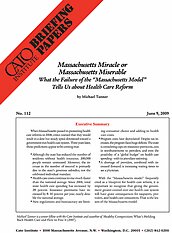When Massachusetts passed its pioneering health care reforms in 2006, critics warned that they would result in a slow but steady spiral downward toward a government-run health care system. Three years later, those predictions appear to be coming true:
- Although the state has reduced the number of residents without health insurance, 200,000 people remain uninsured. Moreover, the increase in the number of insured is primarily due to the state’s generous subsidies, not the celebrated individual mandate.
- Health care costs continue to rise much faster than the national average. Since 2006, total state health care spending has increased by 28 percent. Insurance premiums have increased by 8–10 percent per year, nearly double the national average.
- New regulations and bureaucracy are limiting consumer choice and adding to health care costs.
- Program costs have skyrocketed. Despite tax increases, the program faces huge deficits. The state is considering caps on insurance premiums, cuts in reimbursements to providers, and even the possibility of a “global budget” on health care spending—with its attendant rationing.
- A shortage of providers, combined with increased demand, is increasing waiting times to see a physician.
With the “Massachusetts model” frequently cited as a blueprint for health care reform, it is important to recognize that giving the government greater control over our health care system will have grave consequences for taxpayers, providers, and health care consumers. That is the lesson of the Massachusetts model.

This work is licensed under a Creative Commons Attribution-NonCommercial-ShareAlike 4.0 International License.

